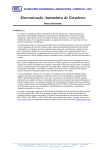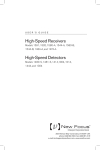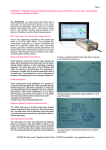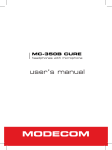Download VIGO System VPXC-5S User`s guide
Transcript
Stand alone preamplifier VPXC-xxS user's guide 129/133 Poznanska St., 05-850 Ozarow Mazowiecki, Poland; tel. +48 22 733 54 20; fax +48 22 733 54 26; e-mail: [email protected] 1 Please note: the information contained in this document is subject to change without further notification. VIGO System reserves the right to alter the performance and any resulting specifications.VS- 11-08-16MB Table of Contents 1. Warranty.................................................................................................................................................. 3 2. VPXC-xxS technical information.............................................................................................................. 4 2.1. VPXC-xxS module description........................................................................................................... 4 2.2. Module physical dimensions.............................................................................................................. 4 2.3. Preamplifier supply voltage................................................................................................................ 5 2.4. Preamplifier load resistance.............................................................................................................. 5 2.5. Supply socket.................................................................................................................................... 5 3. Getting started (regards the module itself as well as the complete IR detecting kit)................................6 3.1. Unpacking......................................................................................................................................... 6 3.2. Installation & connections.................................................................................................................. 6 3.3. Switching on procedure..................................................................................................................... 7 4. VPXC-xxS other related information........................................................................................................8 4.1. CE statement of conformity .............................................................................................................. 8 4.2. Electromagnetic interference............................................................................................................. 8 4.3. Storage information........................................................................................................................... 8 5. Safety instructions................................................................................................................................... 9 6. Troubleshooting..................................................................................................................................... 10 6.1. List of the possible faults and solutions...........................................................................................10 6.1.1. Too high DC level at the output of the preamplifier....................................................................10 6.1.2. Too high current consumption by the preamplifier.....................................................................10 6.1.3. No or too weak response to optical radiation.............................................................................11 6.1.5. Excess noise............................................................................................................................. 11 6.1.6. Unstable signal.......................................................................................................................... 11 6.1.7. Long signal rise/fall time............................................................................................................ 12 129/133 Poznanska St., 05-850 Ozarow Mazowiecki, Poland; tel. +48 22 733 54 20; fax +48 22 733 54 26; e-mail: [email protected] 2 Please note: the information contained in this document is subject to change without further notification. VIGO System reserves the right to alter the performance and any resulting specifications.VS- 11-08-16MB 1. Warranty VIGO System S.A. hereby represents and warrants all Products manufactured by VIGO and sold hereunder to be free from defects in workmanship or material during a period of twelve (12) months from the date of delivery save for products for which a special warranty is given. If any Product proves however to be defective in workmanship or material within the period herein provided VIGO System undertakes to the exclusion of any other remedy to repair or at its own option replace the defective Product or part thereof free of charge and otherwise on the same conditions as for the original Product or part without exten sion to original warranty time. Defective parts replaced in accordance with this clause shall be placed at the disposal of VIGO. VIGO also warrants the quality of all repair and service works performed by its employees to products sold by it. In case the repair or service works should appear inadequate or faulty and should this cause malfunction or nonfunctioning of the product to which the service was performed VIGO shall at its free option either repair or have repaired or replace the product in question. The working hours used by employees of VIGO for such repair or replacement shall be free of charge to the client. This service warranty shall be valid for a period of six (6) months from the date the service measures were completed. This warranty is however subject to following conditions: 1. 2. A substantiated written claim as to any alleged defects shall have been received by VIGO System within thirty (30) days after the defect or fault became known or occurred, and The allegedly defective Product or part shall, should VIGO so require, be sent to the works of VIGO or to such other place as VIGO may indicate in writing, freight and insurance prepaid, properly packed and labeled. This warranty does not however apply when the defect has been caused through 1. 2. 3. 4. 5. 6. 7. 8. 9. normal wear and tear or accident; misuse or other unsuitable or unauthorized use of the Product or negligence or error in storing, maintaining or in handling the Product or any equipment thereof; wrong installation, assembly or failure to service the Product or otherwise follow VIGO's service instructions including any repairs or installation or assembly or service made by unauthorized personnel not approved by VIGO or replacements with parts not manufactured or supplied by VIGO; modifications or changes of the Product as well as any adding to it without VIGO's prior authorization; burned active element by irradiation above damage thresholds electrostatic discharges improper detector bias improper TE cooler bias (TE cooler damage or active element overheating). other factors dependent on the Customer or a third party. Notwithstanding the aforesaid VIGO System liability under this clause shall not apply to any defects arising out of materials, designs or instructions provided by the Customer. This warranty is expressly in lieu of and excludes all other conditions, warranties and liabilities, expressed or implied, whether under law, statute or otherwise, including without limitation any implied warranties of merchantability or fitness for a particular purpose and all other obligations and liabilities of VIGO or its representatives with respect to any defect or deficiency applicable to or resulting directly or indirectly from the Products supplied hereunder, which obligations and liabilities are hereby expressly canceled and waived. VIGO's liability shall under no circumstances exceed the invoice price of any Product for which a warranty claim is made, nor shall VIGO in any circumstances be liable for lost profits or other consequential loss whether direct or indirect or for special damage. RMA Request Instructions: No Product may be returned without first contacting VIGO for a Return Material Authorization ('RMA') number. Please obtain a RMA number at [email protected] before returning any item. When requesting a RMA number, please state your order number, the product you wish to return and the reason for return. We will only accept returns which have a RMA number. Authorized returns are to be shipped according to received instruction from VIGO in appropriate shipping box. An unauthorized return, i.e. one for which an RMA number has not been issued and authorized returns however, shipped with incorrect customs documents - will not be accepted. Please print the RMA number clearly on the return label to avoid any delay in processing. Please send package to: VIGO System S.A. 129/133 Poznanska St., PL 05-850 Ozarow Mazowiecki Poland 129/133 Poznanska St., 05-850 Ozarow Mazowiecki, Poland; tel. +48 22 733 54 20; fax +48 22 733 54 26; e-mail: [email protected] 3 Please note: the information contained in this document is subject to change without further notification. VIGO System reserves the right to alter the performance and any resulting specifications.VS- 11-08-16MB 2. VPXC-xxS technical information 2.1. VPXC-xxS module description The VPXC-xxS is an transimpedance amplifier especially suited to work in cooperation with VIGO uncooled detectors. Both AC and DC coupling is available. Detector bias circuit is included. 2.2. Module physical dimensions Dimensions are given in millimeters. 129/133 Poznanska St., 05-850 Ozarow Mazowiecki, Poland; tel. +48 22 733 54 20; fax +48 22 733 54 26; e-mail: [email protected] 4 Please note: the information contained in this document is subject to change without further notification. VIGO System reserves the right to alter the performance and any resulting specifications.VS- 11-08-16MB 2.3. Preamplifier supply voltage Preamplifier version Power supply value VPXC-0.1S, VPXC-0.3S, VPXC-1S ±15V/±50mA (±10%) VPXC-5S, VPXC-10S, VPXC-20S ±9V/±50mA (±10%) Every type of the VPXC-xxS preamplifier is internally protected against reversing the supply polarity and abnormal voltage increase. Although Preamplifier contains voltage regulators, while powering with the custom made power supply, provide the properly stabilized and filtered voltage. 2.4. Preamplifier load resistance Preamplifier version Optimum load resistance VPXC-0.1S, VPXC-0.3, VPXC-1S VPXC-5S, VPXC-10S, VPXC-20S 1 MΩ 50 Ω Please match the load resistance to the values from the table. Consequences of terminating with incorrect load resistance: • Voltage response may not match the value given in the data sheet, • Preamplifier pulse response may be disturbed due to the line reflection, • In case of 1 MΩ terminated preamplifiers, lower load resistance may increase the supply current consumption and lead to the preamplifier overheat. 2.5. Supply socket Description Pin number GND -VEE 3 6 +VCC 9 DB9 connector 129/133 Poznanska St., 05-850 Ozarow Mazowiecki, Poland; tel. +48 22 733 54 20; fax +48 22 733 54 26; e-mail: [email protected] 5 Please note: the information contained in this document is subject to change without further notification. VIGO System reserves the right to alter the performance and any resulting specifications.VS- 11-08-16MB 3. Getting started (regards the preamplifier itself as well as the complete IR detecting kit) 3.1. Unpacking Before unpacking, verify if there are no visible damages of the package. Report them to the manufacturer or the distributor. 3.2. Installation & connections • Mount the IR preamplifier in the measurement setup, • Connect all elements with cables provided in the package, • Make sure that all the elements are properly connected. The picture shown below presents sample IR detecting kit configuration with interconnections. DB9 – DB9 cable Power supply adaptor VPXC-xxS preamplifier Uncooled IR detector in BNC based package PPS-02 preamplifier supply BNC – BNC cable (signal input) BNC – BNC cable (signal output) 129/133 Poznanska St., 05-850 Ozarow Mazowiecki, Poland; tel. +48 22 733 54 20; fax +48 22 733 54 26; e-mail: [email protected] 6 Please note: the information contained in this document is subject to change without further notification. VIGO System reserves the right to alter the performance and any resulting specifications.VS- 11-08-16MB 3.3. Switching on procedure • Do not switch on the preamplifier power supply until ALL elements of the IR detection kit are properly connected with the proper cables. • Before starting the measurements make sure the load resistance is valid. The VPXC-xxS output should be terminated by 50Ω or 1MΩ resistance depending on the bandwidth and is given in the test data provided on the module. • Do not manipulate any connectors on the active IR kit – this may introduce additional noise to the system or can cause severe damages due to electrostatic discharges. 129/133 Poznanska St., 05-850 Ozarow Mazowiecki, Poland; tel. +48 22 733 54 20; fax +48 22 733 54 26; e-mail: [email protected] 7 Please note: the information contained in this document is subject to change without further notification. VIGO System reserves the right to alter the performance and any resulting specifications.VS- 11-08-16MB 4. VPXC-xxS other related information 4.1. CE statement of conformity VIGO System declares that IR detection kit is fully compliant with: EU Low Voltage Directives: 73/23/EEC, 93/68/EEC EU Electromagnetic Compatibility Directives: 89/336/EEC, 91/263/EEC, 92/31/EEC, 93/68/EEC 4.2. Electromagnetic interference To avoid the electromagnetic interferences (EMI): Please do not put any electromagnetic source close to the IR module. That may cause interference to the input of the transimpedance preamplifier and disturb the useful signal in the IR track 4.3. Storage information To ensure reliable operation and long lifetime of detector, the following conditions should be fulfilled: • Storage temperature: -10ºC ÷ + 50ºC and 10% to 90% humidity, • Avoid exposing to direct sunlight and strong UV/VIS light as this may result in degradation of a detector performance, • Avoid electrostatic discharges (ESD), 129/133 Poznanska St., 05-850 Ozarow Mazowiecki, Poland; tel. +48 22 733 54 20; fax +48 22 733 54 26; e-mail: [email protected] 8 Please note: the information contained in this document is subject to change without further notification. VIGO System reserves the right to alter the performance and any resulting specifications.VS- 11-08-16MB 5. Safety instructions To ensure safe and failure-free operation of the IR detection kit comply with the following precautions: The IR detector is dedicated to measure IR flux. Never use the detector in other applications. Never dismount the case of the preamplifier. Do not open or remove the housing of the device. It may lead to its permanent damage or/and to a risk of electric shock. Handle with care, avoid excessive mechanical shock or vibration. Excessive mechanical stress applied to the package itself or to a device containing the package may result in permanent damage. Use the proper cables to connect elements of the kit, dedicated for specified device only. Never cut or shorten any cable, it may cause damage to your device. Never use cables not approved by VIGO System. Do not replace parts of the IR detection kit - cables, preamplifiers or detectors. Using parts from other IR de tection kit can be the cause of malfunction of your Preamplifier. Never touch the detector window. All connectors must be connected carefully and firmly. Avoid damp locations. The IR preamplifier should be neither installed nor used in high humidity locations. Avoid locations with ambient temperature exceeding preamplifier operating temperature. The IR preamplifier should not be installed in the proximity of radiators, heat outlets, burners or other heat emitting objects. Use proper ESD protection. Ensure stable placement of the device. The IR preamplifier should stand on a stable surface. Some IR detector window materials such as BaF 2 are soft. Particular attention should be paid not to scratch the surface of the window. A damaged window may entirely degrade the detector performance. Important note! If you are setting up own system based on IR detecting system without power supply, please check if the preamplifier power supply are correct. 129/133 Poznanska St., 05-850 Ozarow Mazowiecki, Poland; tel. +48 22 733 54 20; fax +48 22 733 54 26; e-mail: [email protected] 9 Please note: the information contained in this document is subject to change without further notification. VIGO System reserves the right to alter the performance and any resulting specifications.VS- 11-08-16MB 6. Troubleshooting At first, please carefully read the previous parts of this manual, especially Safety instructions. If a problem persists, please check the information given below. General Test Procedure Check: • Whether components of your IR detection kit are connected correctly, • Whether connections are snug-tight, • Whether supply voltages or currents of the components are consistent with the specification, • Attenuation/gain factors in your measurement set-up, • Load resistance at the preamplifier output, • For high frequency output line and the load must be matched to the 50 Ohm preamplifier output, • Whether bandwidths of the components are reasonably well-matched to each other, • Whether the detector is not saturated or damaged by too high irradiation, • Cycle the power of the components off and on again, • After shielding/switching off the radiation source, do you see any signal decrease? If yes, most probably you see a signal from the optical radiation you hope to see, 6.1. List of the possible faults and solutions 6.1.1. Too high DC level at the output of the preamplifier Follow through General Test Procedure. Remove the IR source from the detector field of view or decrease incident beam power of your IR source. If device still has high DC level, contact your technical support. 6.1.2. Too high current consumption by the preamplifier The device is probably damaged, contact your technical support. 129/133 Poznanska St., 05-850 Ozarow Mazowiecki, Poland; tel. +48 22 733 54 20; fax +48 22 733 54 26; e-mail: [email protected] 10 Please note: the information contained in this document is subject to change without further notification. VIGO System reserves the right to alter the performance and any resulting specifications.VS- 11-08-16MB 6.1.3. No or too weak response to optical radiation Follow through General Test Procedure. • Check your radiation source, • If you do not have any other detector to test your radiation source, move a hot object (ex. soldering iron) rapidly in front of the detector, across its whole field of view. (The higher the temperature of the object or shorter the distance to the detector, the higher the optical signal at the detector output.), • Test your detector with another available radiation source. A warm or hot object moved in front of the detector can be used for DC or low frequency AC coupled devices, • Align or improve your optical setup for the maximized signal or signal-to-noise ratio, • Estimate the detector response, taking into account the incident radiation at the detector active area and the responsivity of the detector (or of the IR detector module), and check it against measured values, • Evaluate the noise in the system. Calculate the noise introduced by the detector or detection module basing on their noise density from their data sheets. Check it against measured response of the blinded detector, • Check if the incident radiation will be strong enough to obtain sufficient signal-to-noise ratio. (A signal is easy to pick out of a noise when its peak to peak value is several times greater than of the noise.) If it is lower than expected, consider increasing the incident radiation power on the detector active area, • Check also if the incident radiation is not too strong, causing detector saturation or damage. If you cannot obtain signal sufficiently higher than noise, contact your technical support. 6.1.5. Excess noise First of all check through General Test Procedure. Excess noise may be caused by poor connections, ground connections and ground loops, high background photon flux or EMI (ex. inductive motors driving radiation chopper). You may also decrease the noise by reducing your system bandwidth. If you are unable to identify external excess noise source, contact your technical support. 6.1.6. Unstable signal Check through General Test Procedure. Check: • Cables, • Radiation sources , • If the device is still unstable, contact your technical support. Warning - DC or low frequency signal may vary due to fluctuations of thermal background radiation 129/133 Poznanska St., 05-850 Ozarow Mazowiecki, Poland; tel. +48 22 733 54 20; fax +48 22 733 54 26; e-mail: [email protected] 11 Please note: the information contained in this document is subject to change without further notification. VIGO System reserves the right to alter the performance and any resulting specifications.VS- 11-08-16MB 6.1.7. Long signal rise/fall time Check through General Test Procedure. Check: • The shape of the pulse with another detector if possible, • The operating conditions (bias, optical setup), • If impedance of the detector, cables, preamplifier and your read-out instrument are matched. 129/133 Poznanska St., 05-850 Ozarow Mazowiecki, Poland; tel. +48 22 733 54 20; fax +48 22 733 54 26; e-mail: [email protected] 12 Please note: the information contained in this document is subject to change without further notification. VIGO System reserves the right to alter the performance and any resulting specifications.VS- 11-08-16MB





















